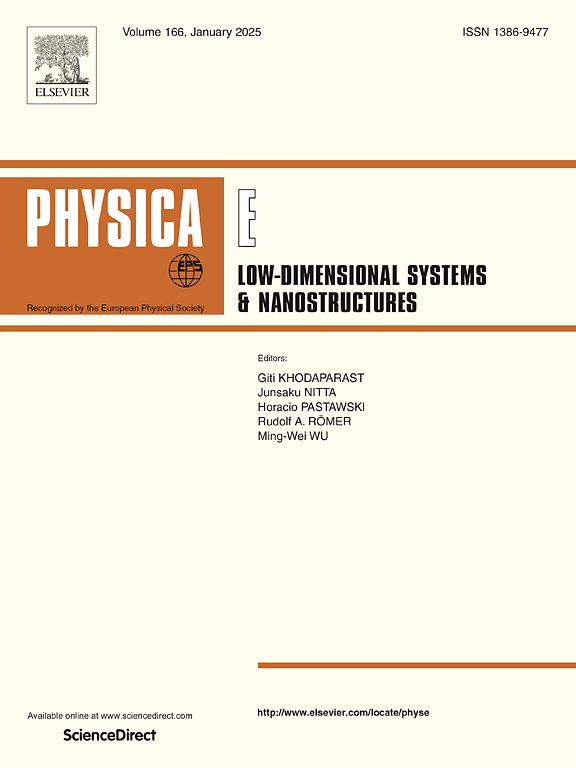二维二元C4X2化合物(X = N, P, As)的二次节点和方节点线研究
IF 2.9
3区 物理与天体物理
Q3 NANOSCIENCE & NANOTECHNOLOGY
Physica E-low-dimensional Systems & Nanostructures
Pub Date : 2025-04-22
DOI:10.1016/j.physe.2025.116279
引用次数: 0
摘要
近年来,二维材料拓扑态的研究得到了重视,作为三维系统研究的补充领域。本研究通过理论计算揭示了单层二元化合物C4X2 (X = N, P, As)的特殊拓扑性质。这些化合物具有简单的电子结构,仅由费米能量附近的两个能带组成,其能带交叉导致了值得注意的拓扑特征,特别是二次节点和Weyl平方节点线。对带形成的机制和色散条件进行了综合分析。与这些化合物相关的边缘态从节点出现并向节点线延伸,表现出广泛的空间分布。这些材料的轻质组成元素确保了拓扑特征和边缘状态保持稳定,即使考虑到自旋轨道耦合效应。为了提高实际适用性,本研究还评估了拓扑状态的应变依赖行为以及材料的各向异性力学性能。总的来说,这些理想拓扑状态的研究,结合候选材料的稳定性,为未来的实验研究奠定了坚实的基础。这项工作有可能促进快速发展的二维拓扑材料领域的重大进展。本文章由计算机程序翻译,如有差异,请以英文原文为准。

Exploring quadratic nodal point and square nodal line in two dimensional binary C4X2 compounds (X = N, P, As)
Recently, the investigation of topological states in two dimensional materials has gained prominence, serving as a complementary area to studies of three dimensional systems. This research presents the exceptional topological properties of the monolayer binary compounds C4X2 (X = N, P, As) through theoretical calculations. These compounds are characterized by a simple electronic structure consisting of only two bands near the Fermi energy and their band crossing leads to noteworthy topological features, specifically a quadratic nodal point and a Weyl square nodal line. A comprehensive analysis of the mechanisms underlying band formation and dispersion conditions has been conducted. The edge states associated with these compounds emerge from the nodal point and extend towards the nodal line, exhibiting extensive spatial distribution. The lightweight constituent elements of these materials ensure that both the topological features and edge states maintain stability, even when accounting for spin-orbit coupling effects. To enhance practical applicability, this study has also assessed the strain-dependent behaviors of the topological states alongside the anisotropic mechanical properties of the materials. Collectively, the investigation of these ideal topological states, in conjunction with the stability of the material candidates, lays a robust foundation for future experimental research. This work has the potential to facilitate significant advancements in the rapidly evolving field of two-dimensional topological materials.
求助全文
通过发布文献求助,成功后即可免费获取论文全文。
去求助
来源期刊
CiteScore
7.30
自引率
6.10%
发文量
356
审稿时长
65 days
期刊介绍:
Physica E: Low-dimensional systems and nanostructures contains papers and invited review articles on the fundamental and applied aspects of physics in low-dimensional electron systems, in semiconductor heterostructures, oxide interfaces, quantum wells and superlattices, quantum wires and dots, novel quantum states of matter such as topological insulators, and Weyl semimetals.
Both theoretical and experimental contributions are invited. Topics suitable for publication in this journal include spin related phenomena, optical and transport properties, many-body effects, integer and fractional quantum Hall effects, quantum spin Hall effect, single electron effects and devices, Majorana fermions, and other novel phenomena.
Keywords:
• topological insulators/superconductors, majorana fermions, Wyel semimetals;
• quantum and neuromorphic computing/quantum information physics and devices based on low dimensional systems;
• layered superconductivity, low dimensional systems with superconducting proximity effect;
• 2D materials such as transition metal dichalcogenides;
• oxide heterostructures including ZnO, SrTiO3 etc;
• carbon nanostructures (graphene, carbon nanotubes, diamond NV center, etc.)
• quantum wells and superlattices;
• quantum Hall effect, quantum spin Hall effect, quantum anomalous Hall effect;
• optical- and phonons-related phenomena;
• magnetic-semiconductor structures;
• charge/spin-, magnon-, skyrmion-, Cooper pair- and majorana fermion- transport and tunneling;
• ultra-fast nonlinear optical phenomena;
• novel devices and applications (such as high performance sensor, solar cell, etc);
• novel growth and fabrication techniques for nanostructures

 求助内容:
求助内容: 应助结果提醒方式:
应助结果提醒方式:


